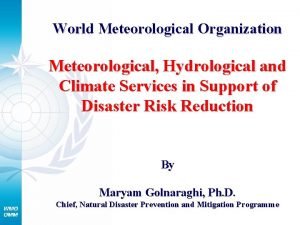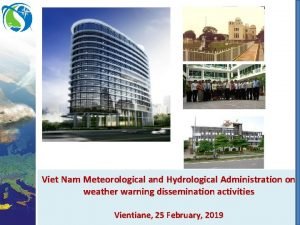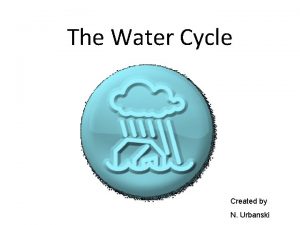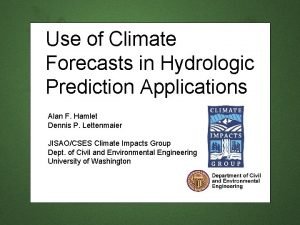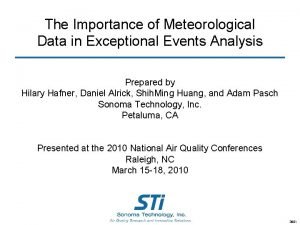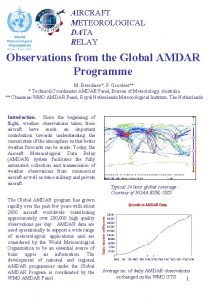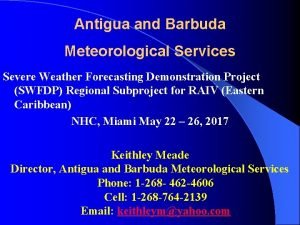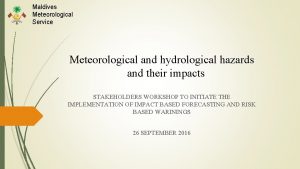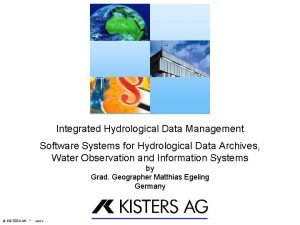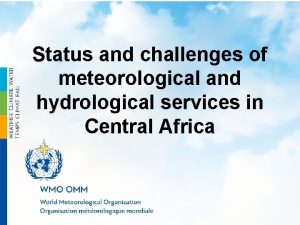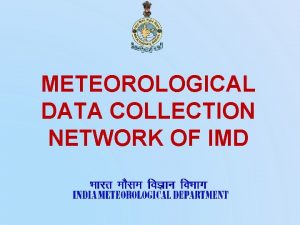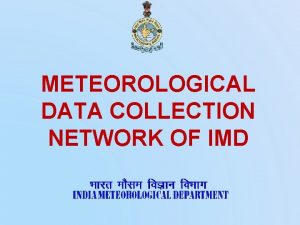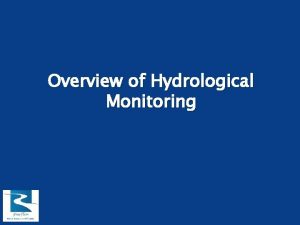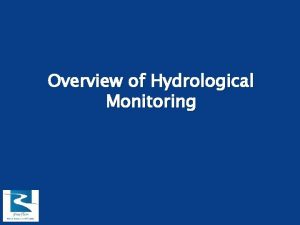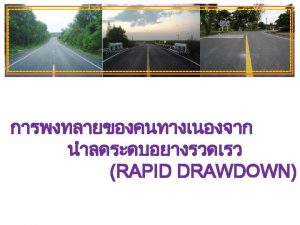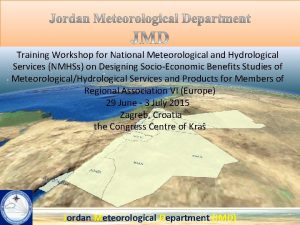METEOROLOGICAL AND HYDROLOGICAL DATA ANALYSIS Hydrological studies require














- Slides: 14

METEOROLOGICAL AND HYDROLOGICAL DATA ANALYSIS Hydrological studies require extensive analysis of Ømeteorological Øhydrological Øand spatial data qto represent the actual processes taking place on the environment and better estimation of quantities out of it.

• Precipitation is the source of all waters which enters the land. • Hydrologists need to understand how the vamount, rate, duration, and quality of precipitation • distribution in space and time ü hydrologic responses of a catchments

• Estimates of regional precipitation are critical inputs to water-balance and other types of models used in water-resource management. • The uncertainties associated with a value of regional precipitation consist of: • 1. Errors due to point measurement • 2. Errors due to uncertainty in converting point measurement data into estimates of regional precipitation

1. 2 Meteorological data • 1. 2. 1 Principles of Data Analysis → a) Corrections to Point Measurements • Rain gages that project above the ground surface causes wind eddies affecting the catch of the smaller raindrops and snowflakes. • The daily measured values need to be updated by applying a correction factor K after corrections for evaporation, wetting lose.

Correction factor for unshielded rain gauges: • Kru = 100 exp (-4. 605 + 0. 062 Va 0. 58) • Correction factor for Alter wind shielded rain gauges: • Kru = 100 exp (-4. 605 + 0. 041 Va 0. 69) • Errors due to splashing and evaporation usually are small and can beneglected.

üSystematic errors often associated with recording type rain gauges 1– 5% of the total catch

b) Estimation of Missing Data • Several approaches are used to estimate the missing values. ü Station Average, ü Normal Ratio, ü Inverse Distance Weighting, ü and Regression methods

Station Average The recommends using this method only when the annual precipitation value at each of the neighboring gauges differs by less than 10% from that for the gauge with missing data. • Where: Px=The missing precipitation record P 1, P 2 , …, Pm = Precipitation records at the neighboring stations M = Number of neighboring stations

Normal Ratio Method If the annual precipitations vary considerably by more than 10 %, the missing record is estimated by the Normal Ratio Method, by weighing the precipitation at the neighboring stations by the ratios of normal annual precipitations.

Inverse Distance Weighting

c) Checking the Consistency of Point Measurements • of the common causes for inconsistency of record are: 1. Shifting of a rain gauge station to a new location 2. The neighbor hood of the station may have undergoing a marked change 3. Change in the immediate environment due to damages due to deforestation, obstruction, etc. 4. Occurrence of observational error from a certain date both personal and instrumental

• The most common method of checking for inconsistency of a record is the Double-Mass Curve analysis (DMC). • The adjustment is done by applying a correction factor K,

1. 3 Areal Estimation • Rain gauges represent only point measurements. • Several approaches have been devised for estimating areal precipitation from point measurements. 1. The Arithmetic mean, 2. Thiessen polygon 3. And the Isohyetal method

1. 4 Hydrological Data • The availability of stream flow data is important for the model calibration process in catchment modelling.
 National meteorological and hydrological services
National meteorological and hydrological services Vietnam meteorological and hydrological administration
Vietnam meteorological and hydrological administration Croatian meteorological and hydrological service
Croatian meteorological and hydrological service Hydrological
Hydrological Condensation process example
Condensation process example Hydrological cycle diagram
Hydrological cycle diagram Hydrological prediction center
Hydrological prediction center Importance of meteorological data
Importance of meteorological data Estofex.org
Estofex.org Aircraft meteorological data relay
Aircraft meteorological data relay Paradigm shift from women studies to gender studies
Paradigm shift from women studies to gender studies Antigua met office
Antigua met office Slidetodoc.com
Slidetodoc.com Data collection procedure and data analysis
Data collection procedure and data analysis Data preparation and basic data analysis
Data preparation and basic data analysis
